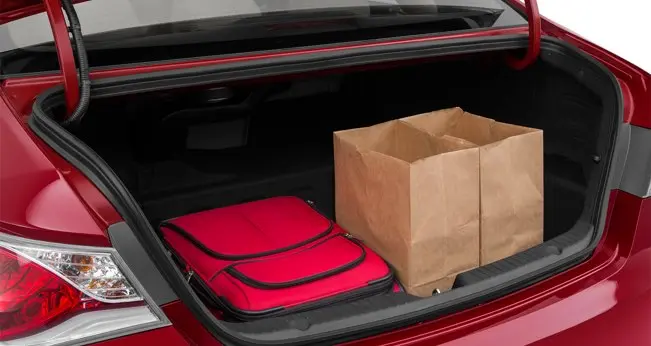These two car types have key differences, but also a growing number of similarities.

You’ve got your coupes, and you’ve got your sedans. Coupes are two-door cars and sedans have four doors. Case closed, right?
Not so fast.
While the number of doors is an important difference, auto manufacturers actually use coupe and sedan platforms differently to build more specialized vehicles for their customers. As a result, the differences between coupes and sedans actually go beyond their exterior styling.
Learning how to define a coupe, and what makes a car a sedan, can help you find the vehicle that best matches your needs and your lifestyle.
Let’s get into it. It’s tempting to think black and white here: sedans are for four adults, and coupes are sportier cars for two grownups and one or maybe two small kids. (You’re not really going to make your mom fold herself into the back of your coupe for a trip to the store, are you?)
But wait. Sedans can be sporty and stylish too. Sexy, even. (Seen a Dodge Charger or a Hyundai Genesis lately?) These adjectives don’t belong solely to the coupe. On the other hand, some coupes allow plenty of extra entry these days (see the Mazda RX-8 and the Hyundai Veloster). Other examples of blurred lines include the Volkswagen CC and the Mercedes-Benz CLA; these two vehicles are listed by their manufacturers as four-door coupes.
What is a Coupe?
Who looks for coupes? Drivers who want something on the sportier side, who are economy-minded, and who don’t have larger families.
The first coupes appeared in the 1800s, when carriage builders tweaked traditional coach designs to shorten them and make it easier for passengers to climb aboard. As the popularity of coupe cars grew in the 1960s, more automotive designers welded hard tops to two-seat, open cars as a nod to their carriage roots.
Soon after, the coupe car term started to blur as manufacturers greatly diminished or completely removed the rear seat to create a sportier 2+2 body style. This term refers to cars that have a sleek, sloping roofline, two doors, and two functional seats up front, plus two tiny seats in back. More recently, auto manufacturers started to apply the coupe definition to the sporty variants of their sedan lineup. As a result, the coupe term has become more popular with manufacturers, who apply it more loosely. Automakers may also offer both a coupe and sedan using the same model line, like the Honda Civic. The ability to clearly define coupe vehicles has become challenging in recent years as a result.
Who looks for coupes? Drivers who want something on the sportier side, who are economy-minded, and who don’t have larger families tend to get the most out of these fun two-door vehicles.
Should for a Used Coupe Near You
What is a Sedan?
The first sedan to hit the marketplace was from the Renault car company. This vehicle had two rows of seats and four doors, but lacked a fully enclosed cabin space. It proved to be a popular style, and Cadillac produced and sold the first completely enclosed sedan in 1906. Other manufacturers quickly followed suit by producing enclosed passenger vehicles which precisely met the sedan definition. Beyond embracing modern styling and features, sedan designs have not changed much over the years.
Along with its two additional doors, the modern sedan has a longer wheelbase than most coupes. This extra length gives both front and rear passengers more room to stretch out. In most sedans, the rear bench seats can seat three adults comfortably with enough leg and head room for all. There’s more cargo space too, which makes sedans like the Toyota Camry ideal for extended shopping excursions and road trips. In an effort to fully define sedan characteristics, these cars all have fixed roofs.
Sedans will appeal to a broader market than coupes; sales of sedans have slid a bit in the last decade as customer began to seek larger SUVs that can carry both passengers and more cargo.
Shop for a Used Sedan Near You
Key Differences Between Sedans and Coupes
Knowing the key differences between sedans and coupes can save you time as you research all the various body styles on the market today. Do you know the differences?
Performance
The coupe’s shorter wheelbase and lighter curb weight naturally boosts this car’s overall performance. Acceleration and braking performance, for example, are noticeably enhanced when a vehicle weighs several hundred pounds less.
Sedans tend to be heavier, but they compensate for the extra weight with optional engine upgrades, like you’ll find on the Nissan Altima. If you’re looking for additional power, it’s possible to choose a larger V6 over a four-cylinder model. These larger, heavier cars often have suspension upgrades that improve their performance and handling.
Exterior style cues
Removing two doors to create a coupe can dramatically change a car’s exterior styling, and gives it a sportier look. The body’s window frames (known as the B and C pillars) adjust slightly to account for changes to the overall length. The result is longer doors and rear windows. The longer doors look great, but can be challenging when you’re parking in smaller lots.
Many sedans, except four-door sports cars, of course, drop the sporty vibe in favor of a luxurious look and feel. The shorter doors make entering and exiting the vehicle much easier for all passengers, and the window and door pillar changes help create a more balanced side-profile appearance.
Interior comfort

The amount of space available in the backseat area of coupes varies considerably from model to model. With some cars, like the Hyundai Genesis, the smaller backseat is tailored to the comfort of the rear passengers despite a bit less leg room. The molded seats and integrated cup holders make riding in the back seat a comfortable experience. Like many other two-door cars, this model has no middle seat, effectively limiting passenger space to just four occupants.
Sedans, like the Honda Accord, don’t compromise on passenger comfort in the front or back seats. Head and leg room is a priority. Furthermore, sedans typically have room for five passengers, thanks to a broader, bench-style seat with three seat belts.
Cargo space

Since sedans are longer cars, they naturally give you more cargo space in the trunk. The Hyundai Sonata, for example, has over 16 cubic feet of cargo space in the trunk, making it great for getting groceries or taking on road trips. Coupes may have less cargo space, but it’s possible, on some models, to fold down the seats and expand the trunk area. Since each model varies in build type and quality, it’s important to look at both the specified cargo space and the interior’s flexibility to determine which vehicle has the most room for your belongings. One exception: the Dodge Challenger, a performance coupe that gives drivers more than 16 cubic feet of cargo space (about the same as a Hyundai Sonata).
Additional considerations before you buy
Sedans tend to be heavier, but they compensate for the extra weight with optional engine upgrades.
When automakers offer a particular model as both a sedan and coupe, in many cases both body style options will come with the same standard features. Optional features are generally available across both body styles as well, though there may be some limitations due to the build variances of sedan vs. coupe configurations. One difference: the Hyundai Genesis coupe comes standard with cloth seats; the sedan gives you leather as an option.
The same performance feature specs tend to be available in both body styles within the same model line. However, drivetrain options can sometimes vary between body styles. Take the 2015 Hyundai Genesis for example; the coupe is only available with a 3.8L engine, plus your choice of automatic or six-speed manual transmission, and is two-wheel drive only. The sedan version gives you the choice of a 3.8L or bigger 5.0L engine, and two-wheel drive or all-wheel drive (and only an automatic transmission — no stickshift).
Each body style in a model line typically has the same basic engine, transmission, and braking components. Suspension components, however, may receive an upgrade in sedans to accommodate the extra weight and length of this body style. Furthermore, if a coupe is marketed as a sporty variant of the sedan, the manufacturer may offer additional performance upgrades.
Coupe vs. Sedan: choosing your ideal vehicle type
In the end, it comes down to the way the vehicle looks, feels, and drives as you make your decision between these two popular body styles. Be sure to look online to compare features and check out descriptive photographs, and then pick three to five sedans or coupes that meet your unique expectations. When you take a test drive, bring down the whole family to determine how well everyone fits inside. At CarMax, you can also take advantage of a 24-hour take-home test drive to make sure you're making the right decision.














